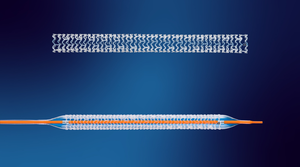Laser Ablation Technology Proves as Good as Gold
July 12, 2010
|
An 18K gold stent with an outer diameter of 2.08 mm and a wall thickness of 140 µm (left) and a 90:10 platinum:iridium-alloy stent (right) with an outer diameter of 1.32 mm and a wall thickness of 152 µm were machined using the Raydiance femtosecond pulse laser platform. (Photo courtesy of Business Wire) |
Because of their radiopacity, resistance to corrosion, and high electrical conductivity, such noble metals as gold and platinum are becoming increasingly beneficial in such medical device applications as heart-rhythm leads, cardiovascular stents, and guidewires used in cardiovascular procedures. In stent and guidewire applications, the precious metals are used as x-ray markers to better enable surgeons to see devices during procedures.
Responding to the increasing need for machined medical device components made from noble metals, Raydiance Inc. (Petaluma, CA) says that it has demonstrated the ability to machine precise, micron-resolution features in gold and platinum, two of the more difficult-to-process materials used in advanced medical devices. Raydiance engineers achieved these results using the company's Smart Light 50 femtosecond pulse laser integrated into a StarCut Tube workstation from Rofin (Plymouth, MI).
Raydiance's ultrafast laser ablates using a process known as nonlinear optical breakdown. This process enables micron-resolution ablation of virtually any material without transferring heat to the part being machined, according to the company.
"Medical device manufacturers have a very difficult time machining precise features in these ductile noble metals," states Scott Davison, president of Raydiance. "Traditional tools--mechanical saws, electron discharge machining, and even nanosecond lasers--introduce all kinds of burrs and thermal effects that necessitate costly postprocessing. The Raydiance platform provides an efficient, athermal solution to this manufacturing problem."
About the Author(s)
You May Also Like



